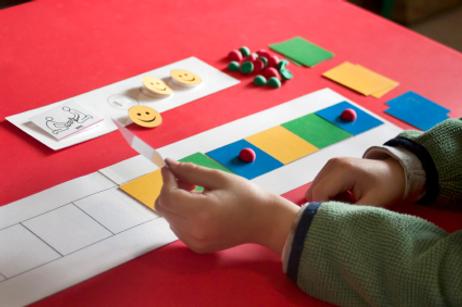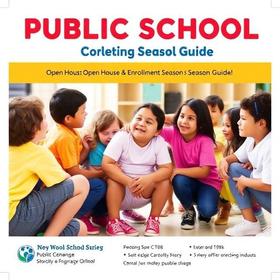According to the Autistic Society's research, approximately fifty children are diagnosed with autism in the United States every day. With increasing number of autistic students across the country, public schools are implementing plans to foster family support and student success.
Since federal law requires that schools provide children with the "least restrictive" environment possible, full inclusion in regular class sizes is often a beneficial pathway for children with autism.
As Abramson of the National Public Radio indicates, there are cases of children with autism who are unable to speak as they are entering early elementary school; however, with the development of inclusive programs in public schools, teachers are reporting that children often overcome social problems, speech problems, and behavioral issues while working with teachers, peers, and parental support.
While autistic students need extra help and assistance, progress is evident in public school programs across the country. Ultimately, according to Abramson, research demonstrates that the earlier children receive help with their autism, the higher the probability that they will develop effective communication skills.
The Early Signs of Autism
With currently half a million children diagnosed with autism in the United States, parents are looking to find out more about symptoms and signs of autistic behavior. However, since the development of each child is unique and variant, some professionals often may try to delay a diagnosis until signs are clear and consistent with a child's behavior to ensure the accuracy of any form of analysis.
According to the Brides 4 Kids organization, there are five early signs that often may be autism indicators, although a diagnosis does not normally occur until a child is three or four years old.
Name Recognition
Children are actually able to learn their names within the first few months of life; typically, babies are responses to the voices of familiar people, and they can often respond with looks, smiles, or a non-verbal reaction.
On the other hand, infants who were later diagnosed with autism typically fail to show responsiveness to their own name. When these infants hear their name called, they tend to only look at the individual 20% of the time – based on research which analyzed one-year-old birthday parties of children diagnosed with autism.
Paired with this, autistic infants also may respond selectively to sounds; in this case, a child may fail to respond to a parent calling his/her name, yet may respond to a different noise, such as classical music, immediately. This symptom is often interpreted as a form of hearing loss.
Social Attention
Around one year old, infants begin engaging in "joint attention." They can shift their focus from toys or games in order to "engage" with people around them. The typical infant begins to look at people, instead of toys, and they begin showing their toys to other people – which demonstrates a quality of sharing. Or, they may begin sharing their experiences with others. For example, an infant may point at a bird, sharing what he or she sees with the parent.
Comparatively, autistic children often struggle with joint attention. In this case, they rarely shift their gaze between objects to people, and they do not display the previously described interactions with people, such as not "showing" a toy to a parent. Furthermore, young children with autism have particular difficulties in jointly attending with others. They rarely follow another's points, do not often shift their gaze back and forth from objects to people, and do not seem to share "being with" the caregiver as they watch and talk about objects, people, or events. They also tend not to "show" a toy to the parent.Imitation
Typically, infants will mimic people around them, such as facial movements, and around 10 months old, they often imitate sounds or movements. Children with autism, on the other hand, display this behavior with more rarity.
Emotional Response
Just as infants typically imitate adults, they also exhibit social responsiveness, including smiling, laughing, or crying depending on what others around them are doing. For example, if their playmates are laughing and playing with toys, an infant will exhibit the same type of behavior.
In comparison, children with autism often exhibit an unawareness of the feelings of others.
Engagement in Pretend Play
As it is commonly seen, young children enjoy imitating social roles as they play. For example, a child may pretend to be a mom, or a dad, or a firefighter, and so forth. Paired with this, a child typically shows an interaction with toys, and he or she may use these toys in their imaginative play, which often occurs around the age of two.
On the other hand, children with autism often display a lack of interest in toys. Instead, they may show more interest in the movement of their limbs, or perhaps the string that is attached to the toy. If they are interested in a particular toy, then they may play with these objects in a way that other children would not.
Early diagnosis of autism is important in helping your child develop communication skills. Working closely with their teachers and classrooms in an inclusive environment gives your child with autism an opportunity to flourish to their fullest potential.
Action Plans for Parents with an Autistic Child
If parents discover they have an autistic child, the first step they can take is to meet with public school specialists, such as resource room teachers, their homeroom teacher(s), and other staff members at the school. The most important element here is to establish open communication to foster support for the child, the family, and the teachers.
Programs in Public Schools
Due to the significant curriculum accommodations for special needs and autistic children in the past decade, autistic children will be fully included in their designated classroom experience. By law, schools must create individualized educational programs for each autistic child.
Autistic children can absolutely attend, grow, and learn within the public school systems of support. Today, programs for autistic children are mostly individually planned (with the IEP process), making the accommodations for any child with special needs very intimate, supportive, and personal.
Due to this individualized plan, there are not currently major autistic programs that are commonly found in public schools across the country; instead of specific programs, the teachers and staff aim to work with the parents and child individually, while also striving to incorporate the child into the daily activities of the standard classroom. Indeed, according to the Yale Herald, research has shown that children with mild autism significantly benefit from being immersed in a “normal” school environment from a young age.
However, parents whose children may have severe autism – who perhaps need assistance eating and going to the restroom – may want to consider private schools. Keep in mind that the under-funded nature of public schools results in a severe lack of qualified special education teachers. If you do decide to send your child to private school, then your public school is indeed required by law to reimburse you for those funds.
Recent Developments
Because the rise in autistic cases has skyrocketed in recent years, scientists and researchers are still debating the causes and treatments for individuals dealing with this condition. If a child is diagnosed with autism, the best plan for success is for the parents to meet with the child’s doctor, and receive a referral to a highly recommended specialist in the field. Again, in using a specialist, an individualized plan can be established to make the pathway to success as uniquely supportive as possible.
Questions? Contact us on Facebook @publiccollegereviews.











